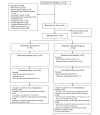Using Robots at Home to Support Patients With Chronic Obstructive Pulmonary Disease: Pilot Randomized Controlled Trial
- PMID: 29439942
- PMCID: PMC5829456
- DOI: 10.2196/jmir.8640
Using Robots at Home to Support Patients With Chronic Obstructive Pulmonary Disease: Pilot Randomized Controlled Trial
Abstract
Background: Socially assistive robots are being developed for patients to help manage chronic health conditions such as chronic obstructive pulmonary disease (COPD). Adherence to medication and availability of rehabilitation are suboptimal in this patient group, which increases the risk of hospitalization.
Objective: This pilot study aimed to investigate the effectiveness of a robot delivering telehealth care to increase adherence to medication and home rehabilitation, improve quality of life, and reduce hospital readmission compared with a standard care control group.
Methods: At discharge from hospital for a COPD admission, 60 patients were randomized to receive a robot at home for 4 months or to a control group. Number of hospitalization days for respiratory admissions over the 4-month study period was the primary outcome. Medication adherence, frequency of rehabilitation exercise, and quality of life were also assessed. Implementation interviews as well as benefit-cost analysis were conducted.
Results: Intention-to-treat and per protocol analyses showed no significant differences in the number of respiratory-related hospitalizations between groups. The intervention group was more adherent to their long-acting inhalers (mean number of prescribed puffs taken per day=48.5%) than the control group (mean 29.5%, P=.03, d=0.68) assessed via electronic recording. Self-reported adherence was also higher in the intervention group after controlling for covariates (P=.04). The intervention group increased their rehabilitation exercise frequency compared with the control group (mean difference -4.53, 95% CI -7.16 to -1.92). There were no significant differences in quality of life. Of the 25 patients who had the robot, 19 had favorable attitudes.
Conclusions: This pilot study suggests that a homecare robot can improve adherence to medication and increase exercise. Further research is needed with a larger sample size to further investigate effects on hospitalizations after improvements are made to the robots. The robots could be especially useful for patients struggling with adherence.
Trial registration: Australian New Zealand Clinical Trials Registry ACTRN12615000259549; http://www.anzctr.org.au (Archived by WebCite at http://www.webcitation.org/6whIjptLS).
Trial registration: ClinicalTrials.gov NCT02672176.
Keywords: chronic obstructive pulmonary disease; hospitalization; medication adherence; rehabilitation exercise; robotics; telehealth.
©Elizabeth Broadbent, Jeff Garrett, Nicola Jepsen, Vickie Li Ogilvie, Ho Seok Ahn, Hayley Robinson, Kathryn Peri, Ngaire Kerse, Paul Rouse, Avinesh Pillai, Bruce MacDonald. Originally published in the Journal of Medical Internet Research (http://www.jmir.org), 13.02.2018.
Conflict of interest statement
Conflicts of Interest: EB, BM, HSA, NK, and KP received funding from Yujin Robot Ltd for unrelated projects on transportation and aged care robots. The remaining authors declare that they have no competing interests.
Figures
References
-
- Seemungal TA, Hurst JR, Wedzicha JA. Exacerbation rate, health status and mortality in COPD--a review of potential interventions. Int J Chron Obstruct Pulmon Dis. 2009;4:203–23. https://www.dovepress.com/articles.php?article_id=3217 - PMC - PubMed
-
- Marciniuk DD, Brooks D, Butcher S, Debigare R, Dechman G, Ford G, Pepin V, Reid D, Sheel AW, Stickland MK, Todd DC, Walker SL, Aaron SD, Balter M, Bourbeau J, Hernandez P, Maltais F, O'Donnell DE, Bleakney D, Carlin B, Goldstein R, Muthuri SK, Canadian Thoracic Society COPD Committee Expert Working Group Optimizing pulmonary rehabilitation in chronic obstructive pulmonary disease--practical issues: a Canadian Thoracic Society Clinical Practice Guideline. Can Respir J. 2010;17(4):159–68. http://europepmc.org/abstract/MED/20808973 - PMC - PubMed
-
- Levack WM, Weatherall M, Reeve JC, Mans C, Mauro A. Uptake of pulmonary rehabilitation in New Zealand by people with chronic obstructive pulmonary disease in 2009. N Z Med J. 2012 Jan 20;125(1348):23–33. - PubMed
Publication types
MeSH terms
Associated data
LinkOut - more resources
Full Text Sources
Other Literature Sources
Medical



